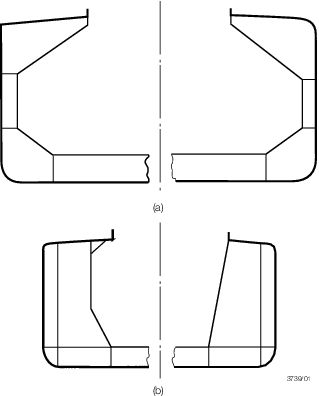
Section
11 Ships for alternate carriage of oil cargo and dry bulk cargo

11.1 Application
11.1.1 The
requirements of this Section apply to ships intended to carry oil
in bulk with a flash point not exceeding 60° (closed-cup test)
or dry bulk cargo alternatively.

11.2 Class notations
11.2.1 Ships
complying with the requirement of this section will be eligible for
one of the following class notations, as applicable.
-
100A1 Oil
or Bulk Carrier, ESP
-
100A1 Oil
or Bulk Carrier strengthened for heavy cargoes, holds ... may be empty,
ESP
-
100A1 Oil
or Bulk Carrier strengthened for heavy cargoes, any hold may be empty,
ESP
-
100A1 Ore
or Oil Carrier, ESP.
11.2.3 The
above notations assume that dry cargoes and oil cargoes will not be
carried simultaneously. However, oil may be retained in slop tanks
when the ship is carrying dry cargo, provided that these tanks comply
with the requirements of the Rules. Gas freeing, inerting, and isolating
by approved arrangements of the remaining tanks and holds before loading
ore or other dry cargoes is the responsibility of the Owner and is
to be in accordance with National and Port Authority requirements.

11.3 Structural configuration and ship arrangement
11.3.1 The
requirements contained in this Section apply to the following ship
types:
-
Oil or bulk carrier
with a basic structural configuration having a single deck hull and
which includes, a double skin side structure, double bottom, hopper
side tanks and topside tanks fitted below the upper deck. A typical
cross-section is indicated in Figure 9.11.1 Structural configuration. However, consideration will be given to other arrangements
on the basis of the requirements of this Section. The requirements
of Pt 4, Ch 7 Bulk Carriers are to be applied.
-
Ore or oil carrier
with a basic structural configuration having a single deck hull and
which includes, a double skin side structure, two longitudinal bulkheads,
and a double bottom throughout the centre hold and wing tanks. A typical
cross-section is indicated in Figure 9.11.1 Structural configuration. The requirements of Pt 4, Ch 11 Ore Carriers are to be applied.

Figure 9.11.1 Structural configuration
11.3.2 Where
oil residues are to be retained on board, slop tanks of sufficient
capacity to meet MARPOL requirements are to be provided and are to
be separated from adjacent spaces by cofferdams which are to be capable
of being flooded, except where the adjacent space is used as a pump-room,
ballast tank, or a fuel oil bunker tank, see also
Pt 4, Ch 9, 1.2 Application and ship arrangement 1.2.2, Pt 5, Ch 15, 1.9 Non-sparking fans for hazardous areas and SOLAS Reg. II-2 Part D - Escape.
11.3.4 Openings
which may be used for cargo operations, for example in the bottom
of topside tanks, are not permitted in bulkheads and decks separating
oil cargo spaces from other spaces not designed and equipped for the
carriage of oil cargoes unless such openings are equipped with alternative
approved means to ensure equivalent integrity.

11.4 Bulkheads in way of dry/oil cargo holds
11.4.2 The
scantlings of vertically corrugated and double plate transverse bulkheads
supported by stools are to be determined in accordance with the requirements
of Pt 4, Ch 9, 7.4 Bulkheads supported by stools 7.4.1, Pt 4, Ch 9, 7.4 Bulkheads supported by stools 7.4.2 and Pt 4, Ch 7, 10.2 Bulkheads supported by stools. In general, the bulkheads
are to have stiffening or corrugations arranged vertically, supported
by top and bottom end stools. Alternative arrangements will, however,
be considered.
11.4.4 The
arrangement of stools and adjacent structure common with dry cargo
holds is to be designed to avoid pockets in which gas could collect.
11.4.5 Where
the form of construction used for transverse bulkheads in wing tanks
is different from that used in centre holds, arrangements are to be
made to ensure continuity of transverse strength through the longitudinal
bulkhead.
11.4.6 Where
partial filling of centre holds with liquid is contemplated, the scantlings
and structural arrangements of the boundary bulkheads are to be capable
of withstanding the loads imposed by the movement of liquid in the
holds. The magnitude of the predicted loadings, together with the
scantling calculations, may require to be submitted.

11.5 Bulkheads in wing tanks of ore or oil carriers

11.6 Cofferdam bulkheads

11.7 Hatchways
11.7.3 Slop
tank hatches and cleaning openings are only permitted on open deck.
Unless these openings are closed with a watertight bolted plate, the
locking arrangements are to be under the control of a responsible
officer.

11.8 Hatch coamings
|